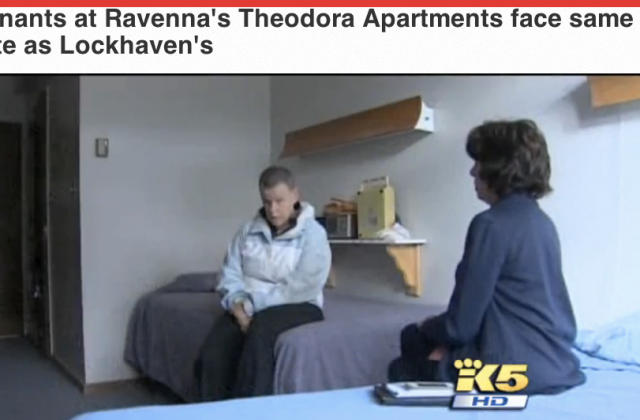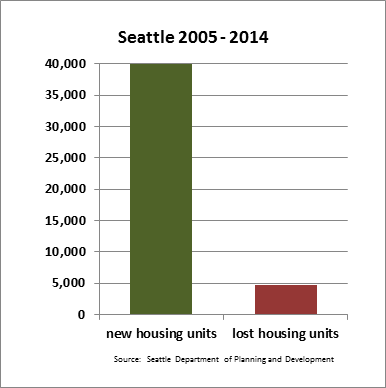Bagshaw’s Statement of Legislative Intent: No More Sad Stories
Councilmember Sally Bagshaw introduced a Statement of Legislative Intent (SLI) directing the Office of Housing to create an Affordable Housing Preservation Plan (AHP). We think this will go a long way to stop the sad stories reported in the press when non-profit buildings get purchased by for profit developers. Have a plan that includes tracking of which buildings in Seattle might be having problems that might force a sale is better for tenants and for helping get the story right in the press.
You’ve seen them more than once, the sad stories of people facing huge rent increases when a developer buys their building. Newspaper accounts or television stories follow the same pattern. Lots of images of the tenants usually old or disabled and wondering where they’ll go. Usually there is no on camera comment from the purchaser of the building who is usually just called “a developer.” The punchline of the story is usually all about “skyrocketing rents” or “growing development.” The general impression is that all over town people are being ejected from their homes to make way for fancy towers of expensive, high end apartments for techies. The stories seem to validate everyone’s worst fears: the more we build, the higher the prices and the more we displace people.
However, we know this isn’t true.
The truth is that very few people have been displaced over the years Seattle has grown the most. Of the buildings that have been demolished to make way for new housing it’s likely that none have been large publicly funded housing units; mostly they have been smaller, less dense market rate units replaced with denser development. This is particularly true in the Low-Rise zones, most of which have old single-family homes that give way to more efficient development.
The sad stories are not only rare, but are almost never caused by a private party trying to acquire a subsidized building. Usually, as in the case of the Theodora in Ravenna, the story is one of a non-profit owner who falls behind on deferred maintenance. When rents go up, part of the reason is to keep up with taking care of an aging building. When rents can’t be raised because of promises made by the non-profit to government funders, then money has to come from somewhere else. When that money can’t be found–and no other non-profit can afford to operate the housing–the non-profit has no choice but to sell.
This is unfortunate, but it is very different story than the one conveyed by the media and anti-growth crowd. The City should have a way of tracking properties like the Theodora and doing what it can to keep the affordable units affordable. If that can’t happen, then tenants should be told a long time in advance and relocated to comparable units somewhere else in the City. Have enough notice that there might be a sale would prevent situations like the Theodora happening again, either because plans would be made for helping people move or the building wouldn’t have to be sold.
The SLI offered by Councilmember Bagshaw starts this conversation. Here’s the key text from the SLI:
Elements of an Affordable Housing Preservation program could include:
- Enforcement of contract or subsidy termination notice requirements;
- Monitoring housing projects with contracts or subsidies that are expiring or could be terminated;
- Conducting outreach to property owners, tenants and stakeholders; and
- Facilitating property transactions that preserve affordable units.
The Executive is requested to submit an AHP program plan to the Housing Affordability and Livability Agenda Advisory Committee established in Resolution 31546, no later than March 31, 2015. The Council’s Committee on Housing Affordability, Human Services and Economic Resiliency will consider recommendations from the advisory committee in the latter half of 2015.
We think the effort should start with buildings owned by non-profits first. Tracking those is a challenge because many are funded by Housing and Urban Development (HUD) and don’t report to the City. But every single building should be on someone’s radar screen. Then, later, the program could be expanded to cover “down rent” buildings that could have troubles with deferred maintenance that could force a sale and raise rents. A SLI is just what it sounds like, an intent to get something started.* So there isn’t a hard and fast outcome from this, but it should, hopefully, inspire some creativity. And we think it is an important first step.
The answer isn’t more mandates but for the City to track affordable units, find out early when there is a problem, act to preserve the units, and if a sale happens make the transition as easy as possible. We’re hopeful Councilmember Bagshaw’s SLI will lead to a collaborative effort from private for and non-profit developers to preserve naturally occurring affordable housing and put an end to the sad stories for good.
*Statement of Legislative Intent (SLI)
A SLI is used for various purposes, including to:
- explain an action, such as providing a rationale for a budget cut;
- give guidance for City policy, such as describing how a program is to operate;
- call for additional study, such as requesting a report analyzing the effectiveness of a new program; or
- create a work program for a department and/or the Council, such as calling for a study of a new concept or approach.
From the City Council’s Budget Glossary.



